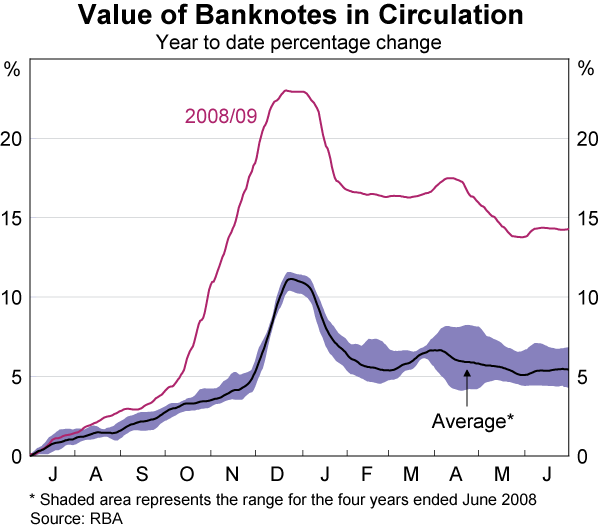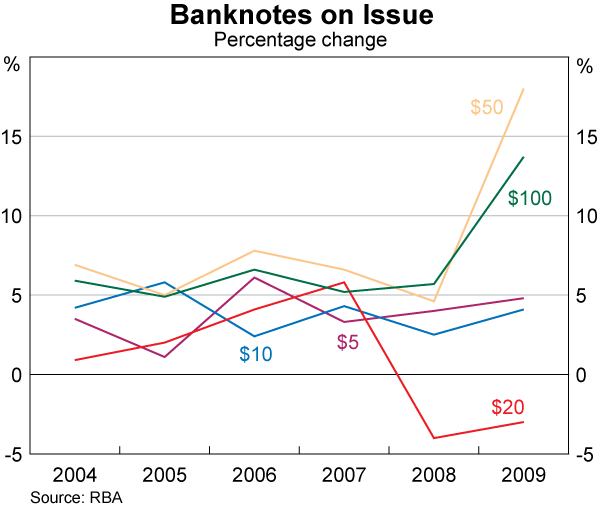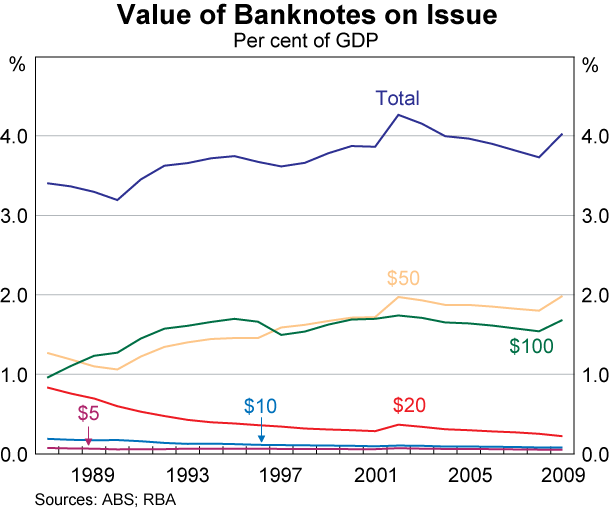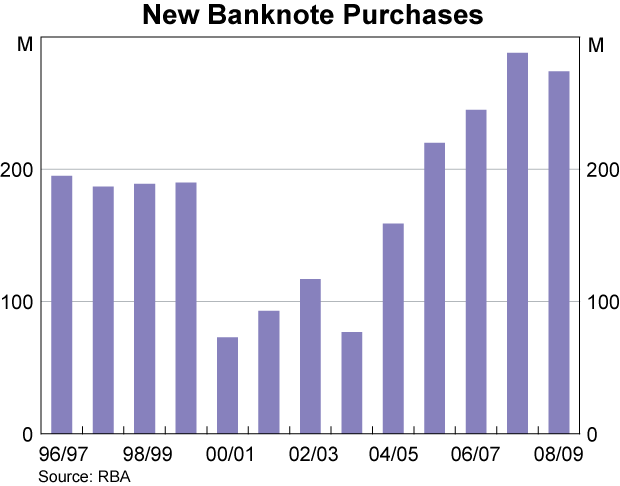Reserve Bank of Australia Annual Report – 2009 Currency
The Reserve Bank is responsible for the production and issuance of new banknotes and the destruction of unfit banknotes. The ultimate goal is to ensure public confidence in the currency, such that banknotes continue to be an effective payment mechanism and a secure store of wealth. This confidence is maintained by:
- making sure there are always enough banknotes available to meet the public's demand;
- maintaining a high quality of banknotes in circulation; and
- conducting research to ensure that the currency remains secure against counterfeiting.
Note Issue Department is responsible for ensuring the supply of quality banknotes and researching security features to be incorporated on banknotes. The Assistant Governor (Currency) also chairs the Boards of Note Printing Australia Limited (NPA), the wholly owned subsidiary that prints Australia's banknotes, and Securency International Pty Ltd, the joint venture company that produces the polymer substrate used for Australia's banknotes.
Note Issue
Banknotes on Issue
The Reserve Bank ensures that there are always sufficient banknotes available to meet anticipated demand from the Australian public. This demand is highly seasonal; it increases sharply in the weeks before Christmas and Easter to accommodate holiday demand, and falls away in the weeks that follow each of these holiday periods. Over time, demand for currency has been rising at an annual increase of around 5 per cent. In late 2008, however, several factors led to a significantly sharper increase in demand. Specifically:
- Developments in global financial markets reduced the public's financial risk appetite. One manifestation of this was that public demand for currency increased as households made large cash withdrawals from financial institutions.
- The sharp depreciation of the Australian dollar encouraged a range of individuals to convert their foreign currency holdings into Australian dollars. These individuals included tourists, expatriates and families of students studying in Australia.
- The Australian Government announced a stimulus package, including direct payments to households, which boosted demand for cash when these payments were made in December.
- In response to these developments, commercial banks increased their precautionary holdings of banknotes to ensure that they would be able to manage possible cash withdrawals at short notice.
The combined effect of these factors was to boost the value of banknotes in circulation by 19 per cent in the three months to December, several times larger than the typical seasonal rise. Although the public's demand for banknotes has since eased, the value of banknotes in circulation remains around 14 per cent higher than at the start of the financial year, well above the average growth rate experienced in recent years.

The increased demand for currency in late 2008 saw currency in circulation as a proportion of nominal GDP rise by 0.3 per cent to 4 per cent. Over the past two decades, the growth in the value of banknotes in circulation has largely matched the nominal growth of the economy, which is broadly in line with the experience in many other developed countries.
Demand was particularly strong for $50 and $100 banknotes. The value of these banknotes on issue rose by 18 per cent and 14 per cent respectively over the past year. This represents the highest annual growth rate for these denominations since 2002, when new cash distribution arrangements were introduced. At the same time, there was a decline in the number of $20 banknotes in circulation. This shift has largely been driven by an increased preference for the $50 banknote in ATMs.

| At end June | $5 | $10 | $20 | $50 | $100 | Total(a) | Total (percentage change) |
|---|---|---|---|---|---|---|---|
| 2004 | 533 | 791 | 2,533 | 15,941 | 14,224 | 34,022 | 5.7 |
| 2005 | 539 | 837 | 2,584 | 16,740 | 14,924 | 35,624 | 4.7 |
| 2006 | 572 | 857 | 2,690 | 18,044 | 15,903 | 38,066 | 6.9 |
| 2007 | 591 | 894 | 2,846 | 19,228 | 16,730 | 40,289 | 5.8 |
| 2008 | 614 | 917 | 2,732 | 20,111 | 17,690 | 42,064 | 4.4 |
| 2009 | 644 | 954 | 2,651 | 23,721 | 20,117 | 48,087 | 14.3 |
| (a) Includes $1 and $2 banknotes remaining on issue | |||||||

As at end June 2009, there were 1 billion banknotes in circulation worth $48.1 billion. This is equivalent to 47 banknotes worth $2,200 for every Australian.
New Banknote Purchases
The Reserve Bank held a sufficient stock of $5 and $10 banknotes to meet public demand, and therefore did not need to print these denominations during the year. In the case of higher denominations, the amount held in stock was not sufficient and during the year the Bank purchased 98 million $20 banknotes, 130 million $50 banknotes and 46 million $100 banknotes from NPA.

Distribution
In addition to the stocks of banknotes maintained by the Reserve Bank, the commercial banks also maintain a surplus stock of banknotes in approved cash centres located throughout Australia. These stocks ensure there are sufficient banknotes to meet their customers' day-to-day currency requirements. Commercial banks are encouraged to replenish these stocks by dealing directly with each other, but have the option of sourcing additional banknotes from the Reserve Bank's National Note Processing and Distribution Centre, located within NPA in Victoria. The importance of maintaining these surplus stocks of banknotes to accommodate movements in public demand was highlighted in late 2008 when demand for banknotes increased sharply.
Banknote Quality
In order to maintain a high quality of banknotes in circulation, the Reserve Bank regularly issues new banknotes and withdraws unfit banknotes. These activities maintain the functionality of banknotes for handling by the public and for processing through the various banknote accepting and dispensing machines that are increasingly present in the community. High-quality banknotes also assist the public's ability to detect counterfeits.
The commercial banks and armoured car companies play an important role in achieving this quality objective. The Reserve Bank provides incentives for banks and armoured car companies to sort unfit banknotes from their contingency holdings and for investment in banknote sorting machines.
The Reserve Bank monitors banknote quality by periodically sampling the banknotes held by the commercial banks and armoured car companies. Since the introduction of the note quality scheme in 2006, the quality of these banknotes has improved appreciably. The proportion of banknotes rated as high quality has increased from 78 per cent in 2006 to 85 per cent in June 2009. Banknotes deemed to be unfit by the commercial banks and armoured car companies are returned to the Reserve Bank's banknote processing centre in Victoria and destroyed.
Some banknotes become damaged in circulation beyond the normal levels of wear and tear and become unsuitable for processing through high-speed sorting equipment. The Reserve Bank has a policy of paying value for severely damaged banknotes that can be authenticated as genuine Australian banknotes. This includes banknotes significantly damaged or contaminated as a result of natural disasters, such as the floods in southern Queensland and the Victorian bushfires.
Although commercial banks can assess damaged banknotes and pay the assessed value for them, all damaged banknotes are returned to the Reserve Bank for final assessment and destruction. Under this policy, most damaged banknotes receive full value, including ATM dye-stained banknotes submitted by commercial banks. However, where a large piece of a banknote is missing, only the appropriate partial value is paid. During 2008/09, the Bank assessed around 25,000 damaged banknote claims, and paid out around $8.1 million.
Counterfeiting in Australia
In line with its objective of maintaining confidence in Australia's banknotes, the Reserve Bank monitors the incidence of Australian counterfeits passed. By international standards, counterfeiting in Australia continues to be quite low. Specifically, around 7,700 counterfeits, mainly of poor quality, were passed in Australia in 2008/09. These counterfeits had a nominal face value of approximately $423,000. This equates to around seven counterfeits passed per million genuine banknotes in circulation, which is similar to the previous year. The average rate of counterfeits passed per million banknotes in circulation in other developed countries that have publicly available statistics has been around 100 in the past two years.
As has been the case for a number of years, the $50 banknote continued to be the most commonly counterfeited denomination, comprising approximately 80 per cent of the number of counterfeits passed in 2008/09.
| $5 | $10 | $20 | $50 | $100 | Total | |
|---|---|---|---|---|---|---|
| Number | 48 | 166 | 208 | 6,136 | 1,104 | 7,662 |
| Nominal value ($) | 240 | 1,660 | 4,160 | 306,800 | 110,400 | 423,260 |
| Parts per million | 0.4 | 1.7 | 1.4 | 13.0 | 5.7 | 7.4 |
Importantly, there is no evidence of ‘professional’ counterfeiting in Australia, with the vast majority of counterfeits being printed on paper and only a crude attempt made to simulate the clear window and its printed image. These counterfeits are easily detected by visual inspection and feel.
Notwithstanding the low level of counterfeiting activity, the Reserve Bank takes all counterfeiting incidents seriously, and is actively engaged in improving the protection of Australia's banknotes. This includes:
- an ongoing research and development program into improving the security of Australia's banknotes;
- working with law enforcement agencies in Australia and overseas to monitor and combat emerging counterfeiting trends; and
- the establishment of a dedicated counterfeit examination laboratory to assist the Australian Federal Police (AFP) with the administration and handling of counterfeits.
The Reserve Bank is continuing to work with the AFP to develop new counterfeit processing procedures, with the aim of gaining deeper insights into counterfeiting trends and the techniques used by counterfeiters. It is hoped that this additional information could be used to assist law enforcement agencies with counterfeit-related investigations.
Banknote Research and Development
The Reserve Bank continues to conduct research and development into features designed to enhance the security of polymer banknotes. A number of the Bank's research initiatives are conducted jointly with a range of third parties, including private companies, universities and research institutions. The Bank's research and development group also works closely with a number of overseas central banks to discuss and explore issues, ideas and solutions related to banknote authentication and counterfeit deterrence. The Bank is a member of the Central Bank Counterfeit Deterrence Group, an association of central banks and printing authorities that works towards developing strategic responses to counterfeiting threats worldwide.
Numismatics
Following a review of the results of the annual auctions of numismatic banknotes held in 2007 and 2008, the Reserve Bank has examined a number of alternative models for numismatic sales in an attempt to refine the arrangements further. In future, numismatic banknotes will be made available by the Bank for a specific period during each year at fixed prices. Details of the new sales facility will be announced in the second half of 2009.
Note Printing Australia
Note Printing Australia is a wholly owned subsidiary of the Reserve Bank, located in Victoria, which produces Australian banknotes and operates the National Note Processing and Distribution Centre under contract to the Bank. NPA also produces Australian passports for the Department of Foreign Affairs and Trade, banknotes for a small number of other countries in the Asia-Pacific region and banknote security products for a number of overseas banknote producers.
NPA operates with a charter from the Reserve Bank, under which its primary focus is to produce Australian banknotes efficiently and to a high level of quality. NPA's operations are overseen by a board of directors appointed by the Bank. The board at present comprises four Reserve Bank executives: Bob Rankin, Assistant Governor (Currency) as Chairman; Keith Hall, Assistant Governor (Banking and Payments); Darryl Ross, Chief Financial Officer; and Lindsay Boulton, Head of Risk Management. During the year, Les Austin and Richard Warburton AO retired from the Board. The company's chief executive is Bernhard Imbach, who has occupied the position since early 2008.
In support of the company's focus on quality and efficiency, a major investment program is under way. When completed in early 2010, this program will have ensured that key equipment and systems at NPA represent the best current practices in the banknote industry.
In 2008/09, NPA produced 403 million banknotes, comprising 275 million for Australia and 128 million for other countries, including Brunei, Malaysia and Papua New Guinea. NPA also produced 2.1 million passports during the year. Most passports produced this year were of the new series, launched by the Department of Foreign Affairs and Trade in May 2009.
NPA earned a profit after tax of $6.1 million in 2008/09, broadly in line with the previous year. The financial accounts for NPA are consolidated with those of the Reserve Bank.
Securency
Securency is a joint venture between the Reserve Bank and Innovia Films, a major manufacturer of polypropylene films based in the United Kingdom. Securency produces high-security substrate for banknotes and other security documents by applying proprietary coatings and features to specialised films manufactured by Innovia. The principal product of the company is Guardian®, the substrate for use in banknote printing.
Securency has a board comprising eight voting directors, four appointed by each of the Reserve Bank and Innovia, with the Managing Director, Myles Curtis, as a non-voting director. The directors appointed by the Bank are Bob Rankin (Chairman), John Akehurst (a member of the Reserve Bank Board), Les Austin and Darryl Ross. Securency's headquarters are in Victoria.
Securency produces Guardian® substrate at plants in Victoria and in Queretaro, Mexico. The latter is owned by Securency Mexico, S.A. DE C.V., a joint venture between Securency and Banco de Mexico, the Mexican central bank. The Mexican plant commenced operations in December 2008, and provides capacity to supply the growing demand for Guardian® in Latin America as well as contingent support for the plant in Victoria.
During 2008/09, Securency produced Guardian® substrate for banknotes in the following countries: Australia, Brunei, Chile, Guatemala, Honduras, Hong Kong, Malaysia, Mexico, Nigeria, Papua New Guinea, Romania, Singapore and Vietnam. Several countries, including Chile, Guatemala, Honduras and Nigeria, have issued Guardian®-based banknotes for the first time or announced conversion of additional denominations to Guardian® during the year.
Securency has a strong commitment to research and development, ensuring that the company can continue to offer innovative and effective solutions to demands for security features in banknote substrate. In keeping with this commitment, the company has invested in a new centre for research and development (located in Victoria adjacent to the production plant) to accommodate the research staff and facilities. The new centre also provides a platform for future collaborative work with third parties to enhance research into banknote security in the future. The centre was opened in July 2009.
Securency earned a profit after tax of $7.9 million in 2008 on sales of $120 million, most of which were for export. The Reserve Bank equity accounts for its investment in Securency.
Late in the financial year, a series of media articles appeared in a Melbourne newspaper, The Age, alleging impropriety related to Securency's international sales and marketing activities, in particular its use of agents as its representatives in developing countries.
The Board of Securency has measures in place designed to ensure the maintenance of high standards of integrity in the company's operations and has ensured that the company has strict and unambiguous protocols in place governing the use of agents. The effectiveness of the company's implementation of these measures has been regularly audited and these audits have found no evidence of non-compliance. The allegations were therefore treated very seriously, and when they were first raised the Board of Securency promptly requested an independent investigation by the AFP. This investigation began immediately and the Board has ensured that all possible assistance has been given to the AFP.
The Board of Securency also engaged an external accounting practice to undertake a thorough independent review of the company's policies and practices in relation to the use of agents, to ensure that they remain at best practice. At the AFP's request, Securency delayed the start of this review until the AFP had completed its initial assessment of the allegations. The review, which is now in progress, is expected to take several months to complete.
The Board of Securency has kept the Reserve Bank and its other shareholder informed of its actions and decisions. The measures it has taken have the full support of the Reserve Bank and the other shareholder.